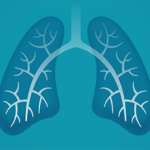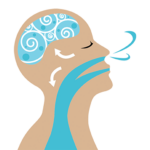
Our lungs fully develop by 25 years of age.1 In time, their function begins to naturally decline; airways and blood vessels become stiffer and stale air can build up and limit fresh air from entering.2 The amount of oxygen entering the bloodstream decreases, leading to fatigue when completing everyday activities, such as walking up stairs. Factors such as air pollution and respiratory infections tend to accelerate the aging process of the lungs. Engaging in daily breathing exercises can assist in keeping the lungs in good shape and maintain their ability to defend against viruses that potentially damage and impede the respiratory system.1–5 Pranayama is the formal yoga practice for controlled breathing and improved lung capacity. The exercises, poses, and breathing techniques associated with Pranayama are aimed at strengthening the respiratory system, which will not only improve lung function, but also boost the immune system as well. 2,6
Tips for Pranayama
- Practice in a well-ventilated area and keep your space clean and free of pollutants.
- Create a routine and stick with it. Practice in the morning or evening, but be sure to practice at the same time and place every day.
- Your stomach should be empty. Practice at least four hours before or after eating.
- If you have cardiac or respiratory conditions or are pregnant, consult with your healthcare physician before practicing these breathing exercises.
Ujjayi Pranayama (Conqueror Breath)
This exercise can be used to slow and smooth breathing patterns.
In your designated Pranayama spot, take a few breaths in through your nose and out through your mouth. An integral part of Conqueror Breath is to incorporate a “hissing” sound into your breathing pattern. To achieve this sound, aim your breath to across the back of your throat with a lasting “Ha” sound while exhaling. After practicing a few times, repeat the above with a closed mouth, creating a hissing sound. The objective is to slowly inhale and exhale through your nose and focus on breathing flow for 5 to 8 minutes. Eventually, you can increase your practice to 10 to 15 minutes. After, return to normal breathing for a few minutes and lie down in Shavasana (Corpse Pose) for a minute or so.8,9
Sitali Pranayama (Cooling breath)
This exercise naturally lowers body temperature and can improve focus when feeling fatigued or overwhelmed. This is beneficial when fighting a fever caused by the flu or a respiratory infection.
Align your head, neck, and spine while in a restful position, and breath naturally with your eyes closed. When you’re ready, make an “O” shape with your lips and stick out your tongue as you curl it lengthwise (akin to a straw). Deeply inhale through the straw-tongue, focusing on the cooling effect. Then retract your tongue, close your mouth, and slowly exhale through your nose. Practice for two to three minutes, switch to regular breathing, and repeat for a few rounds.8
Sama Vritti Pranayama (Breath Control)
This calming exercise is used to revitalize energy levels through balanced breathing.
Start by sitting cross-legged on the floor, upright in a chair, or lying on your back in your Pranayama spot. With your eyes closed, become aware of your natural breathing pattern, and take five breaths without any modifications. To begin the exercise, count to four as you inhale and hold your breath for a moment. Then, slowly exhale for four more counts. Wait a few moments before repeating. The number of seconds can be adjusted to what feels best for you; just be sure the count for inhalations and exhalations are the same. Continue for several minutes.8
Nadi Shodhan Pranayama (Alternate Nostril Breathing Technique)
This breathing exercise helps boost immunity, reduce stress levels, and improves respiratory endurance.
To begin, find a comfortable position, relax your hips while straightening your spine, and close your eyes. With your palm facing upward, place your non-dominant hand on your corresponding knee (e.g., right hand on right knee). Place the index and middle fingers of your dominant hand between your eyebrows while placing your ring and pinky finger on the left nostril of your nose while the thumb should be on your right nostril. These fingers will alternative in closing each nostril at a time during the exercise. Take a deep, natural, and gentle breath in, and, with the first exhale, lightly close the right nostril by pressing with your thumb and allow the air to flow out of your left nostril. Then, inhale through your left nostril and lightly close it with your ring and pinky fingers as you exhale through your right nostril. One round has been achieved after you’ve inhaled and exhaled through each nostril; aim for 5 to 9 rounds each day.7,8
 FAST FACT: Pranayama improves exercise tolerance for patients with the common inflammatory lung disease, chronic obstructive pulmonary disease (COPD)5 and better the symptoms of asthma, a condition caused by inflamed, narrowed airways. SOURCE: Saxena T and Saxena M. The effect of various breathing exercises (pranayama) in patients with bronchial asthma of mild to moderate severity. Int J Yoga. 2009;2(1):22–25.
FAST FACT: Pranayama improves exercise tolerance for patients with the common inflammatory lung disease, chronic obstructive pulmonary disease (COPD)5 and better the symptoms of asthma, a condition caused by inflamed, narrowed airways. SOURCE: Saxena T and Saxena M. The effect of various breathing exercises (pranayama) in patients with bronchial asthma of mild to moderate severity. Int J Yoga. 2009;2(1):22–25.
Sources
1. Harvard Health Publishing site. Lung health and disease. Breathing life into your lungs. April 2018. https://www.health.harvard.edu/lung-health-and-disease/breathing-life-into-your-lungs. Accessed 5 April 2020.
2. The American Lung Association site. Lung health and wellness. Breathing exercises. Updated 24 March 2020. https://www.lung.org/lung-health-diseases/wellness/breathing-exercises. Accessed 5 April 2020.
3. The Yoga Institute site. Pranayama-types-and-benefits. How to do Pranayama, types of Pranayama & their benefits in daily Life. https://theyogainstitute.org/pranayama-types-and-benefits/.
Accessed 5 April 2020.
4. Jerath R, Crawford MW, Barnes VA, and Harden K. Self-regulation of breathing as a primary treatment for anxiety. Appl Psychophysiol Biofeedback. 2015;40(2):107–15.
5. Kaminsky DA, Guntupalli KK, Lippmann J, et al. Effect of Yoga Breathing (Pranayama) on exercise tolerance in patients with chronic obstructive pulmonary disease: a randomized, controlled trial. J Altern Complement Med. 2017;23(9):696–704.
6. Kupershmidt S, and Barnable T. Definition of a yoga breathing (Pranayama) protocol that improves lung function. Holist Nurs Pract. 2019;33(4):197–203.
7. Hakked CS, Balakrishnan R, and Krishnamurthy MN. Yogic breathing practices improve lung functions of competitive young swimmers. Journal of Ayurveda and Integrative Medicine. 2017;8: 99–104.
8. The Art of Living site. Yoga & breathing-techniques. Pranayama: The beginner’s guide to yoga breathing exercises. https://www.artofliving.org/us-en/yoga/breathing-techniques/yoga-and-pranayama.
Accessed 5 April 2020.
9. Yoga Journal site. Yoga poses. Conqueror breath. Updated 12 April 2017. https://www.yogajournal.com/poses/conqueror-breath. Accessed 5 April 2020.





